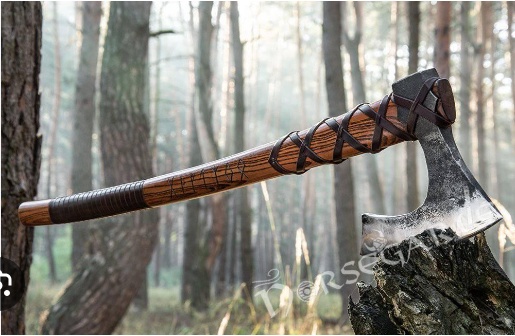In the rugged landscapes of the Viking age, trade was not merely a matter of convenience but often a necessity for survival. Among the most coveted commodities were weapons, particularly the iconic Viking axes. These versatile tools of war and craftsmanship played a crucial role in inter-village trade, fostering alliances, securing resources, and shaping the dynamics of Norse society. Let's delve into the intricate networks of trade and exchange that revolved around the formidable Viking axe.
The Role of Viking Axes in Trade: Viking axes were more than just implements of destruction; they were symbols of status, craftsmanship, and power. Crafted with care by skilled blacksmiths, these weapons were prized possessions, sought after by warriors and chieftains alike. However, the demand for axes extended beyond the battlefield. Axes served as essential tools for everyday tasks such as woodworking, farming, and building, making them indispensable in Norse society.
Inter-Village Trade Networks: Viking villages were interconnected through a web of trade routes, both by land and sea. Axes, along with other goods such as furs, textiles, and foodstuffs, formed the backbone of these trading networks. Villages specialized in producing certain goods based on local resources and expertise, creating a system of interdependence that fueled economic growth and cultural exchange.
Bartering for Axes: The exchange of axes between villages often involved bartering, with goods of equivalent value traded for these prized weapons. Villages with access to abundant natural resources, such as iron-rich mines or dense forests for timber, held an advantage in axe production. In return for axes, they sought goods that were scarce in their own region, such as grain, livestock, or exotic imports.
Strategic Alliances and Diplomacy: The trade of weapons, including axes, played a strategic role in diplomatic relations between Viking communities. Chieftains sought to forge alliances with neighboring villages through the exchange of gifts, including finely crafted axes. These weapons served as symbols of friendship and mutual defense, strengthening ties between allied settlements and deterring potential adversaries.
Cultural Significance: Beyond their economic and strategic importance, Viking axes held profound cultural significance. They were imbued with symbolism and mythology, often adorned with intricate designs and inscriptions reflecting Norse beliefs and traditions. The exchange of axes at trading gatherings was not just a transaction but a reaffirmation of cultural identity and solidarity among the Norse people.
Legacy and Modern Interpretations: While the Viking age has long passed, the legacy of inter-village trade and the symbolic power of the axe endure in modern times. Historical reenactments and cultural festivals pay homage to these traditions, showcasing the craftsmanship of Viking-era weapons and the spirit of exchange that characterized Norse society. And amidst the festivities, the resounding echo of the Viking axe serves as a reminder of the enduring legacy of trade and diplomacy in shaping human history.
Viking axes were more than mere weapons; they were instruments of trade, diplomacy, and cultural exchange that shaped the fabric of Norse society. Through the exchange of axes between villages, alliances were forged, resources were shared, and traditions were preserved. And though the age of the Vikings has long passed, the legacy of their trade networks and the symbolic power of the axe continue to resonate in the annals of history. Norse axes


No comments yet